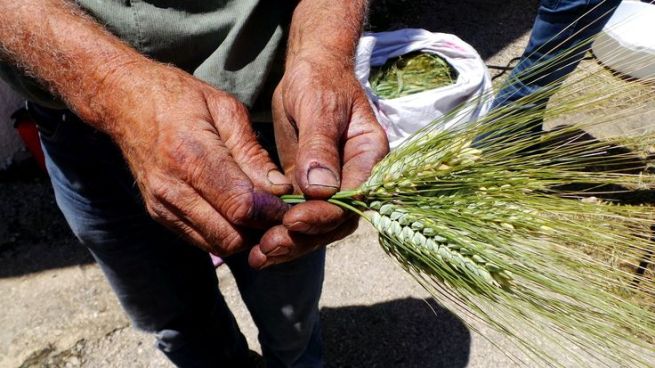post 246/365

“Lebanon’s exceptional location and its singular morphology have contributed to making it a hub of botanic biodiversity. It is one of the nuclear centers of genetic species of wheat, barley, lentils and vetch, their cultivation dating back more than 5,000 years. Other agricultural species originating from Lebanon include olives, figs, grapes, pomegranates and carob. Foods made from these plants lie at the basis of the local culinary traditions.
Wheat and bread, sheep and goat milk and cheeses, grapes and carob are foods that originate from the interaction of history, ecology and geography. They form the cornerstone of the Lebanese food traditions. They are the alimentary expression of the landscape.” (Rami Zurayk, slow food foundation)
Lebanon is home to a large number of local wheat species. Many of the traditional bread wheat varieties are becoming extinct due to the invasion of the local markets since the 1950s by cheap wheat from Australia, Canada and the US. Only the varieties used for the production of Burghul, or crushed wheat, have survived.
Salamouni wheat is one of the land species of wheat still grown in Lebanon, especially in the Bekaa, where the original, mother race of Salamouni still grows wild in the regions of Ham, Aarsal and Nabha. It is a soft, low yielding variety but, in spite of these shortcomings, it has survived because it is the raw material for burghul. The original species is still found growing in the wild, a fact of great significance to its history and genetic background in this area, where it continues to be intensively cultivated.
Salamouni wheat is the raw material for local staple foods such as bread, freekeh, and Burghul. It comes in two sub-varieties: white (the most common) and red.
White salamouni is a soft, low yielding variety planted under rain fed conditions. It responds poorly to fertilization. In spite of its shortcomings, it is still cultivated locally because in the opinion of local farmers, especially in the Bekaa, it is the best wheat for Burghul and kishik production as it possesses superior processing qualities for the preparation of traditional dishes utilizing Burghul as their main ingredient.
Burghul, or cracked wheat, is believed originally to have been a Kurdish product, has been found in the Middle East since 1300 AD and has been traded by the Arabs along the Mediterranean coast since 1600 AD. Burghul is still part of the regular diet in the Levantine countries, but since WWI it has been frequently supplanted with rice, considered to be more exotic.
Due to its minimal processing, Burghul conserves most of the vitamins, minerals and essential elements found in wheat. Compared to white rice, bulgur has more fiber and protein, a lower glycemic index, and higher levels of most vitamins and minerals.
To make Burghul, whole wheat is boiled for several hours in large pots until the outer layer showed some cracks, but care is taken not to overcook the wheat as, at the end of the process, the Burghul needs only be half cooked to accommodate for further cooking. The processing procedure, specifically the boiling, takes place at the end of the summer after harvest, making it a communal activity that brings families together. After boiling it is then sundried on the rooftops and sent to the mill to be cracked, and have its bran removed. This milling process creates Burghul in 2 different sizes, coarse used for pilafs and fine for dishes such as kibbeh and tabbouleh.
Back in the days most rural inhabitants were poor and low on resources. Meat was a luxury few could afford. Burghul at the time was used to maximize the quantity of a meat dish while creating a family size dish from a small portion of meat. Also used in tabbouleh to make the salad more filling. This process gave the Lebanese villagers their daily food.
On special occasions like weddings and religious festivities, people would put forth the best they had to offer. Burghul, the poor man’s food, would be replaced by rice, a more exotic and expensive product, showcasing the wealth of the family, while Burghul would be left in the back of the pantry. Hence the Lebanese saying: “Rice is living the high life while Burghul has committed suicide.”






